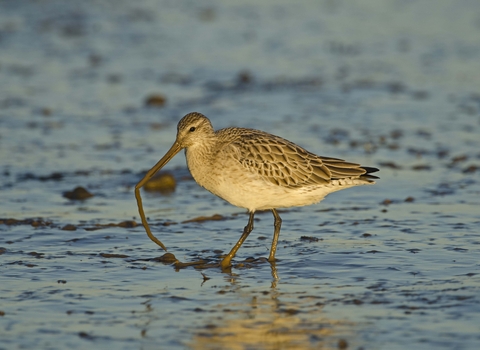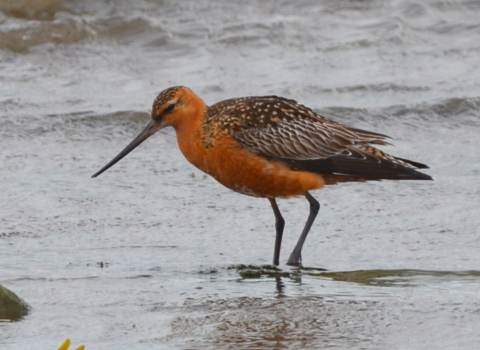
Bar-tailed godwit feeding on ragworm ©David Tipling/2020VISION
Bar-tailed godwit
The bar-tailed godwit winters in the UK in the thousands; look for it around estuaries like the Thames and Humber. In spring, the males display arresting breeding plumage, with brick-red heads, necks and chests.
Scientific name
Limosa lapponicaWhen to see
July to AprilSpecies information
Category
Statistics
Length: 33-42cmWingspan: 75cm
Weight: 300-370g
Average lifespan: 5 years
Classified in the UK as Amber under the Birds of Conservation Concern 5: the Red List for Birds (2021). Listed as Near Threatened on the global IUCN Red List of Threatened Species.
Habitats
About
The bar-tailed godwit is a large, tall wader that breeds in Arctic Scandinavia and Siberia, and migrates here in the thousands, either for the whole winter or en route to wintering grounds further south. Large numbers can be spotted in estuaries such as the Thames, Dee, Humber and Wash.How to identify
During spring and summer, adult bar-tailed godwits have dark brown and grey backs and brick-red heads, necks and underparts. In winter, they are streaky-grey above and white below. When they fly, bar-tailed godwits have a barred tail, and a white wedge on the rump and back; their feet only just stick out past their tail. They are shorter-necked and -legged than black-tailed godwits, and have a slightly upturned bill.Distribution
Can be seen throughout the year, but winters in large numbers on estuaries and around most of the UK's coastline.Did you know?
During the winter, bar-tailed Godwits often commute between the Wash on the east coast and the estuaries of North West England, sometimes moving back and forth between the two overnight.
A shore thing; Godwits visit our coasts and estuaries for food
Photo by Adam Jones
How to tell the difference between similar wading birds
Dunlin or knot, common snipe or jack snipe, black-tailed godwit or bar-tailed godwit? Here are our tips to help you tell these similar species apart.

A shore thing; Godwits visit our coasts and estuaries for food
Photo by Adam Jones
How to tell the difference between similar wading birds
Dunlin or knot, common snipe or jack snipe, black-tailed godwit or bar-tailed godwit? Here are our tips to help you tell these similar species apart.
